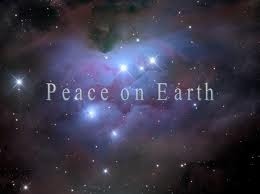Andrew Cort's Blog, page 30
December 27, 2011
THE GREAT QUESTION OF SCIENCE AND EPISTEMOLOGY. (HAVE YOU AN ANSWER?)
Tweet
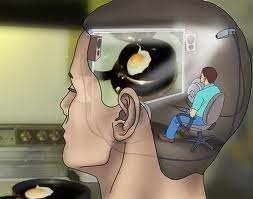 Suppose we see, and thus become aware of, a tree.
Suppose we see, and thus become aware of, a tree.
This statement seems simple enough, but this is one of those precarious occasions where we casually speak of something spectacularly ineffable as if we knew what it meant. When we say we "become aware" of a tree, what are we talking about ? What does this mean?
Let's consider this carefully. We say we "see the tree": that is, we perceive it by means of the eye. We can scientifically analyze this event quite substantially as follows:
A ray of light bounces off the tree and enters the eye. The light traverses the lens, which, due to the laws of optics, flips the light ray upside down and focuses it on the back wall of the eye chamber. This inner wall is lined with tiny nerve endings called rods and cones. The rods and cones are stimulated by the energy of the light, and they respond by sending electrical transmissions down the Optic Nerve. This nerve reaches its endpoint deep within the brain in a section we call the 'visual area'. The multitude of brain cells that comprise the 'visual area' now receive the electrical stimulation transported to them by the optic nerve, and they respond with a great flurry of electrical activity of their own. We can then analyze this activity at the profound level of the atoms and particles that comprise these brain cells, and we discover that these protons, neutrons and electrons react to the incoming electrical impulse by changing their positions and rates of vibration. And then we see the tree.
 Huh? And then we see the tree?
When? How?
When our atoms start to vibrate differently? But we do not see vibrating atoms. We see an object 'out there'. What does the cognitive experience of envisioning a tree have to do with vibrating atomic particles in the back of the skull? Where is the link between these two utterly disparate things? Our description of physiological phenomena deep within the tissues of the brain has only gotten us further away from the tree.
Huh? And then we see the tree?
When? How?
When our atoms start to vibrate differently? But we do not see vibrating atoms. We see an object 'out there'. What does the cognitive experience of envisioning a tree have to do with vibrating atomic particles in the back of the skull? Where is the link between these two utterly disparate things? Our description of physiological phenomena deep within the tissues of the brain has only gotten us further away from the tree.
We have learned about many physiological and electrochemical processes that occur concurrently when we see something, but in no way does this explain what 'seeing' is. There remains a huge and critical gap between (1) our knowledge of vibrating particles, and (2) our 'awareness' of a tree.
This inscrutable gap lies between Matter (which includes the tree, the sense organs, and the vibrating atoms in the Brain), and Consciousness (an invisible 'experience of awareness' occurring within the Mind). Objective scientific analysis can provide no logical connection between the two – once we speak of invisible subjective experience, we are completely outside its realm. Neither can Reason explain it away.
 We find ourselves between worlds, between the Mind and the Senses, between the unmanifest realm of Spirit and the manifest realm of Matter.
We find ourselves between worlds, between the Mind and the Senses, between the unmanifest realm of Spirit and the manifest realm of Matter.
So here is the million dollar question:
How does a 'Sense Perception' cross over into 'Mind'? How does an impression pass beyond the senses and the vibrating atoms, traverse the mysterious 'gap', and sink into the awareness of our consciousness?
What are your thoughts?
***YOUR COMMENTS ARE ALWAYS WELCOME!***
And Please Note: If you enjoy my Blog Posts, you will certainly enjoy my books.

 Suppose we see, and thus become aware of, a tree.
Suppose we see, and thus become aware of, a tree. This statement seems simple enough, but this is one of those precarious occasions where we casually speak of something spectacularly ineffable as if we knew what it meant. When we say we "become aware" of a tree, what are we talking about ? What does this mean?
Let's consider this carefully. We say we "see the tree": that is, we perceive it by means of the eye. We can scientifically analyze this event quite substantially as follows:
A ray of light bounces off the tree and enters the eye. The light traverses the lens, which, due to the laws of optics, flips the light ray upside down and focuses it on the back wall of the eye chamber. This inner wall is lined with tiny nerve endings called rods and cones. The rods and cones are stimulated by the energy of the light, and they respond by sending electrical transmissions down the Optic Nerve. This nerve reaches its endpoint deep within the brain in a section we call the 'visual area'. The multitude of brain cells that comprise the 'visual area' now receive the electrical stimulation transported to them by the optic nerve, and they respond with a great flurry of electrical activity of their own. We can then analyze this activity at the profound level of the atoms and particles that comprise these brain cells, and we discover that these protons, neutrons and electrons react to the incoming electrical impulse by changing their positions and rates of vibration. And then we see the tree.
 Huh? And then we see the tree?
When? How?
When our atoms start to vibrate differently? But we do not see vibrating atoms. We see an object 'out there'. What does the cognitive experience of envisioning a tree have to do with vibrating atomic particles in the back of the skull? Where is the link between these two utterly disparate things? Our description of physiological phenomena deep within the tissues of the brain has only gotten us further away from the tree.
Huh? And then we see the tree?
When? How?
When our atoms start to vibrate differently? But we do not see vibrating atoms. We see an object 'out there'. What does the cognitive experience of envisioning a tree have to do with vibrating atomic particles in the back of the skull? Where is the link between these two utterly disparate things? Our description of physiological phenomena deep within the tissues of the brain has only gotten us further away from the tree. We have learned about many physiological and electrochemical processes that occur concurrently when we see something, but in no way does this explain what 'seeing' is. There remains a huge and critical gap between (1) our knowledge of vibrating particles, and (2) our 'awareness' of a tree.
This inscrutable gap lies between Matter (which includes the tree, the sense organs, and the vibrating atoms in the Brain), and Consciousness (an invisible 'experience of awareness' occurring within the Mind). Objective scientific analysis can provide no logical connection between the two – once we speak of invisible subjective experience, we are completely outside its realm. Neither can Reason explain it away.
 We find ourselves between worlds, between the Mind and the Senses, between the unmanifest realm of Spirit and the manifest realm of Matter.
We find ourselves between worlds, between the Mind and the Senses, between the unmanifest realm of Spirit and the manifest realm of Matter. So here is the million dollar question:
How does a 'Sense Perception' cross over into 'Mind'? How does an impression pass beyond the senses and the vibrating atoms, traverse the mysterious 'gap', and sink into the awareness of our consciousness?
What are your thoughts?
***YOUR COMMENTS ARE ALWAYS WELCOME!***
And Please Note: If you enjoy my Blog Posts, you will certainly enjoy my books.
Published on December 27, 2011 11:30
December 26, 2011
KWANZAA AND THE SEVEN PRINCIPLES
Tweet
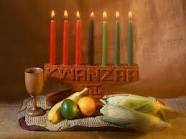
Annual Founder's Kwanzaa Message SHARING AND SUSTAINING THE WORLD
Dr. Maulana Karenga
"The celebration of the 45th Anniversary of Kwanzaa is a significant marker and milestone in itself, not only because of what it says about the expansive message and en-during meaning that Kwanzaa has for millions throughout the world African community, but also because of what it says about us as a people. For it speaks to our profound commitment to self-determination; to cultural reaffirmation and the celebration of ourselves; to our right and responsibility to speak our own special cultural truth in a multicultural world; and to the practice and promotion of Kwanzaa's core principles, the Nguzo Saba, the Seven Principles, the hub and hinge on which the holiday turns.
As always, the season and celebration of Kwanzaa rightfully calls to mind its origins in the ancient African first-fruit harvest celebrations and the model of the harvest which stresses the cooperative creation, gathering and sharing of good, specifically food as a life-sustaining good; gratitude for the bountifulness and beauty of the world; and the commitment to protect and preserve the earth as both a source of life and a site of the sacred. This Kwanzaa comes with an increased concern for the well-being of the world because of the continuing injustice and oppression imposed on humans and the injury and injustice inflicted on the earth. And as Dr. Wangari Mathaai stated, "today we are faced with a challenge that calls for a shift in our thinking," a shift that stops us from destroying the very basis of human life on the planet, and causes us to "assist the earth to heal her wounds and in the process heal ourselves."
It is here that we link the concept and practice of sharing the world with that of sustaining the world, for the well-being and flourishing of humans are tied to the health and wholeness of the world. Therefore, for our ancestors and us, sustainment is a dual concept of both well-being and right-being of and in the world, a world of social and environmental justice, peace, physical and spiritual well-being and ongoing develop-ment. Here the Nguzo Saba are again posed as a vital and valuable way to walk, work and struggle in the world for the well-being, wholeness and flourishing of ourselves and the world. And their central and summary message is: walk gently, act justly and relate rightly in and for the world.
(1) The principle of Umoja (unity) speaks to our need to develop and sustain a sense of oneness, righteous and rightful togetherness in the small and large circles and significant relations of our lives, from family and friendship to community and the cosmos. It urges us to practice a principled and peaceful togetherness rooted in mutual respect; justice; care and concern; security of person; and equitably shared goods. And it calls on us to stand in solidarity with the oppressed, suffering and struggling peoples of the world in the cooperative achievement of these goods.
(2) The principle of Kujichagulia (Self-Determination) instructs us to assert ourselves in self-defining and dignity-affirming ways in the world; and to create the miracles, monuments and meaningful relationships and achievements we want in our lives. And it reaffirms our right and responsibility to live liberating and liberated lives; to value and dialog constantly with our own culture; retrieve and bring forth the best of what it means to be African and human, and speak this unique and equally valid and valuable truth to the world. And it upholds the right of all peoples in the world to demand and do likewise.
(3) The principle of Ujima (Collective Work and Responsibility) teaches us that we must build the good and sustainable com-munities, societies and world we all want and deserve to live in and leave to those after us. This means, as Dr. Mary McLeod Bethune taught us, that "We must remake the world. The task is nothing less than that." This means engaging and solving the major problems of the world, including: poverty; famine and food insecurity; housing; environmental degradation; economic security; HIV/AIDS and other health issues; education; racism; sexism; corporate plunder; war; occupation; crime and the criminal injustice system.
(4) Ujamaa (Cooperative Economics) reaffirms the ethics of the harvest, shared work and shared wealth. It thus is opposed to in-equitable distribution of wealth, and resource monopoly and plunder by the rich and powerful. And it teaches us to privilege the poor and vulnerable, and uphold the right of all peoples to live lives of freedom, dignity, well-being and ongoing development. Ujamaa also urges us to give rightful recognition and support to the small farmers and farm workers of the world for the vital role they play in feeding and sustaining people and the planet, especially in the context of the globalization of agriculture and its destructive effects on the lives and lands of the people.
(5) The principle of Nia (Purpose) teaches us to embrace and respond creatively to the collective vocation of restoring to our people the position and possibilities of great achievements thru doing good in the world. For the sacred teaching of our ancestors in the Husia say that "the wise are known by their wisdom and the great are known by their good deeds." And in the Odu Ifa, they tell us that we "humans are divinely chosen to bring good in the world" and that this is the fundamental mission and meaning in human life.
(6) The principle of Kuumba (Creativity) teaches us the moral obligation "to do al-ways as much as we can in the way we can in order to leave our community more beautiful and beneficial than we inherited it." Thus, we must practice serudj ta, constantly repair and remake the world, a Maatian concept with ethical and aesthetic, as well as natural and social implications, and which expansively means: to repair the damaged, raise up the ruined, replenish the depleted, rejoin the severed; strengthen the weakened; set right the wrong; and make flourish the fragile and undeveloped.
(7) Finally, the principle of Imani (Faith) teaches and urges us to hold fast to the faith of our ancestors, that reassures us that through cooperative work and struggle, the famine and food insecurity in Somalia, the Horn of Africa, and the rest of the world, can be ended; that the human-caused catastrophe of Katrina will not occur again; that the fields and forests of Haiti will blossom, grow abundant grain and fruit again; and that every other plundered, polluted and depleted place will do likewise. And it is a faith that assures us we can truly transform ourselves and the world, and insure clean air, pure water, safe and nutritious food for everyone, and a free, just, secure, dignity-affirming and flourishing life and future for all the world.
Dr. Maulana Karenga, Professor and Chair of Africana Studies, California State University-Long Beach; Executive Director, African American Cultural Center (Us); Creator of Kwanzaa; and author of Kwanzaa: A Celebration of Family, Community and Culture and Introduction to Black Studies, 4th Edition, www.MaulanaKarenga.org.
***YOUR COMMENTS ARE ALWAYS WELCOME!***
And Please Note: If you enjoy my Blog Posts, you will certainly enjoy my books.


Annual Founder's Kwanzaa Message SHARING AND SUSTAINING THE WORLD
Dr. Maulana Karenga
"The celebration of the 45th Anniversary of Kwanzaa is a significant marker and milestone in itself, not only because of what it says about the expansive message and en-during meaning that Kwanzaa has for millions throughout the world African community, but also because of what it says about us as a people. For it speaks to our profound commitment to self-determination; to cultural reaffirmation and the celebration of ourselves; to our right and responsibility to speak our own special cultural truth in a multicultural world; and to the practice and promotion of Kwanzaa's core principles, the Nguzo Saba, the Seven Principles, the hub and hinge on which the holiday turns.
As always, the season and celebration of Kwanzaa rightfully calls to mind its origins in the ancient African first-fruit harvest celebrations and the model of the harvest which stresses the cooperative creation, gathering and sharing of good, specifically food as a life-sustaining good; gratitude for the bountifulness and beauty of the world; and the commitment to protect and preserve the earth as both a source of life and a site of the sacred. This Kwanzaa comes with an increased concern for the well-being of the world because of the continuing injustice and oppression imposed on humans and the injury and injustice inflicted on the earth. And as Dr. Wangari Mathaai stated, "today we are faced with a challenge that calls for a shift in our thinking," a shift that stops us from destroying the very basis of human life on the planet, and causes us to "assist the earth to heal her wounds and in the process heal ourselves."
It is here that we link the concept and practice of sharing the world with that of sustaining the world, for the well-being and flourishing of humans are tied to the health and wholeness of the world. Therefore, for our ancestors and us, sustainment is a dual concept of both well-being and right-being of and in the world, a world of social and environmental justice, peace, physical and spiritual well-being and ongoing develop-ment. Here the Nguzo Saba are again posed as a vital and valuable way to walk, work and struggle in the world for the well-being, wholeness and flourishing of ourselves and the world. And their central and summary message is: walk gently, act justly and relate rightly in and for the world.
(1) The principle of Umoja (unity) speaks to our need to develop and sustain a sense of oneness, righteous and rightful togetherness in the small and large circles and significant relations of our lives, from family and friendship to community and the cosmos. It urges us to practice a principled and peaceful togetherness rooted in mutual respect; justice; care and concern; security of person; and equitably shared goods. And it calls on us to stand in solidarity with the oppressed, suffering and struggling peoples of the world in the cooperative achievement of these goods.
(2) The principle of Kujichagulia (Self-Determination) instructs us to assert ourselves in self-defining and dignity-affirming ways in the world; and to create the miracles, monuments and meaningful relationships and achievements we want in our lives. And it reaffirms our right and responsibility to live liberating and liberated lives; to value and dialog constantly with our own culture; retrieve and bring forth the best of what it means to be African and human, and speak this unique and equally valid and valuable truth to the world. And it upholds the right of all peoples in the world to demand and do likewise.
(3) The principle of Ujima (Collective Work and Responsibility) teaches us that we must build the good and sustainable com-munities, societies and world we all want and deserve to live in and leave to those after us. This means, as Dr. Mary McLeod Bethune taught us, that "We must remake the world. The task is nothing less than that." This means engaging and solving the major problems of the world, including: poverty; famine and food insecurity; housing; environmental degradation; economic security; HIV/AIDS and other health issues; education; racism; sexism; corporate plunder; war; occupation; crime and the criminal injustice system.
(4) Ujamaa (Cooperative Economics) reaffirms the ethics of the harvest, shared work and shared wealth. It thus is opposed to in-equitable distribution of wealth, and resource monopoly and plunder by the rich and powerful. And it teaches us to privilege the poor and vulnerable, and uphold the right of all peoples to live lives of freedom, dignity, well-being and ongoing development. Ujamaa also urges us to give rightful recognition and support to the small farmers and farm workers of the world for the vital role they play in feeding and sustaining people and the planet, especially in the context of the globalization of agriculture and its destructive effects on the lives and lands of the people.
(5) The principle of Nia (Purpose) teaches us to embrace and respond creatively to the collective vocation of restoring to our people the position and possibilities of great achievements thru doing good in the world. For the sacred teaching of our ancestors in the Husia say that "the wise are known by their wisdom and the great are known by their good deeds." And in the Odu Ifa, they tell us that we "humans are divinely chosen to bring good in the world" and that this is the fundamental mission and meaning in human life.
(6) The principle of Kuumba (Creativity) teaches us the moral obligation "to do al-ways as much as we can in the way we can in order to leave our community more beautiful and beneficial than we inherited it." Thus, we must practice serudj ta, constantly repair and remake the world, a Maatian concept with ethical and aesthetic, as well as natural and social implications, and which expansively means: to repair the damaged, raise up the ruined, replenish the depleted, rejoin the severed; strengthen the weakened; set right the wrong; and make flourish the fragile and undeveloped.
(7) Finally, the principle of Imani (Faith) teaches and urges us to hold fast to the faith of our ancestors, that reassures us that through cooperative work and struggle, the famine and food insecurity in Somalia, the Horn of Africa, and the rest of the world, can be ended; that the human-caused catastrophe of Katrina will not occur again; that the fields and forests of Haiti will blossom, grow abundant grain and fruit again; and that every other plundered, polluted and depleted place will do likewise. And it is a faith that assures us we can truly transform ourselves and the world, and insure clean air, pure water, safe and nutritious food for everyone, and a free, just, secure, dignity-affirming and flourishing life and future for all the world.
Dr. Maulana Karenga, Professor and Chair of Africana Studies, California State University-Long Beach; Executive Director, African American Cultural Center (Us); Creator of Kwanzaa; and author of Kwanzaa: A Celebration of Family, Community and Culture and Introduction to Black Studies, 4th Edition, www.MaulanaKarenga.org.
***YOUR COMMENTS ARE ALWAYS WELCOME!***
And Please Note: If you enjoy my Blog Posts, you will certainly enjoy my books.
Published on December 26, 2011 10:44
FROM AN OBITUARY IN THE LONDON TIMES
Tweet
 "Today we mourn the passing of a beloved old friend, Common Sense, who has been with us for many years. No one knows for sure how old he was, since his birth records were long ago lost in bureaucratic red tape. He will be remembered as having cultivated such valuable lessons as:
"Today we mourn the passing of a beloved old friend, Common Sense, who has been with us for many years. No one knows for sure how old he was, since his birth records were long ago lost in bureaucratic red tape. He will be remembered as having cultivated such valuable lessons as:
- Knowing when to come in out of the rain;
- Life isn't always fair;
- and Maybe it was my fault.
Common Sense lived by simple, sound financial policies (don't spend more than you can earn) and reliable strategies (adults, not children, are in charge).
His health began to deteriorate rapidly when well-intentioned but overbearing regulations were set in place.
Reports of a 6-year-old boy charged with sexual harassment for kissing a classmate, teens suspended from school for using mouthwash after lunch, and a teacher fired for reprimanding an unruly student, only worsened his condition.
Common Sense lost ground when parents attacked teachers for doing the job that they themselves had failed to do in disciplining their unruly children.
Common Sense lost the will to live as the churches became businesses and criminals received better treatment than their victims.
Common Sense finally gave up the will to live, after a woman failed to realize that a steaming cup of coffee was hot. She spilled a little in her lap, and was promptly awarded a huge settlement.
Common Sense was preceded in death, by his parents, Truth and Trust, by his wife, Discretion, by his daughter, Responsibility, and by his son, Reason.
He is survived by his 4 stepbrothers:I Know My Rights
I Want It Now
Someone Else Is To Blame
I'm A Victim"
***YOUR COMMENTS ARE ALWAYS WELCOME!***
And Please Note: If you enjoy my Blog Posts, you will certainly enjoy my books.

 "Today we mourn the passing of a beloved old friend, Common Sense, who has been with us for many years. No one knows for sure how old he was, since his birth records were long ago lost in bureaucratic red tape. He will be remembered as having cultivated such valuable lessons as:
"Today we mourn the passing of a beloved old friend, Common Sense, who has been with us for many years. No one knows for sure how old he was, since his birth records were long ago lost in bureaucratic red tape. He will be remembered as having cultivated such valuable lessons as:- Knowing when to come in out of the rain;
- Life isn't always fair;
- and Maybe it was my fault.
Common Sense lived by simple, sound financial policies (don't spend more than you can earn) and reliable strategies (adults, not children, are in charge).
His health began to deteriorate rapidly when well-intentioned but overbearing regulations were set in place.
Reports of a 6-year-old boy charged with sexual harassment for kissing a classmate, teens suspended from school for using mouthwash after lunch, and a teacher fired for reprimanding an unruly student, only worsened his condition.
Common Sense lost ground when parents attacked teachers for doing the job that they themselves had failed to do in disciplining their unruly children.
Common Sense lost the will to live as the churches became businesses and criminals received better treatment than their victims.
Common Sense finally gave up the will to live, after a woman failed to realize that a steaming cup of coffee was hot. She spilled a little in her lap, and was promptly awarded a huge settlement.
Common Sense was preceded in death, by his parents, Truth and Trust, by his wife, Discretion, by his daughter, Responsibility, and by his son, Reason.
He is survived by his 4 stepbrothers:I Know My Rights
I Want It Now
Someone Else Is To Blame
I'm A Victim"
***YOUR COMMENTS ARE ALWAYS WELCOME!***
And Please Note: If you enjoy my Blog Posts, you will certainly enjoy my books.
Published on December 26, 2011 05:00
December 25, 2011
MERRY CHRISTMAS!
Published on December 25, 2011 01:00
December 23, 2011
THE CHRISTMAS MIRACLE, PART 2: SPIRIT BECOMES FLESH
Tweet
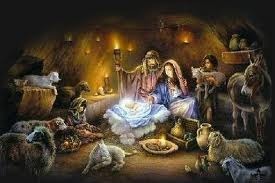 In those days, a decree went forth from Caesar Augustus that there was to be a Census taken of all the world. Everyone was ordered to go to their own home towns to be registered. So Joseph and Mary journeyed to Bethlehem, the birthplace of David, for Joseph was the descendant of kings. And in Bethlehem, which means "House of Bread", and which signifies this realm of body and flesh, Mary's time came and she gave birth to her son. Because there was no room for them in the inn, Mary gave birth to Jesus in a stable carved out of a cave behind the inn, she wrapped him in bands of cloth for swaddling clothes, and cradled him in a manger – a feedbox for animals. Formed at the Beginning in the Heaven above Heaven, Christ was then conceived and born at the level of Earth – the Spirit had become Flesh.
In those days, a decree went forth from Caesar Augustus that there was to be a Census taken of all the world. Everyone was ordered to go to their own home towns to be registered. So Joseph and Mary journeyed to Bethlehem, the birthplace of David, for Joseph was the descendant of kings. And in Bethlehem, which means "House of Bread", and which signifies this realm of body and flesh, Mary's time came and she gave birth to her son. Because there was no room for them in the inn, Mary gave birth to Jesus in a stable carved out of a cave behind the inn, she wrapped him in bands of cloth for swaddling clothes, and cradled him in a manger – a feedbox for animals. Formed at the Beginning in the Heaven above Heaven, Christ was then conceived and born at the level of Earth – the Spirit had become Flesh.Gabriel then came to the shepherds who were keeping careful watch over their flocks that night. The glory of the Lord shone around him, and at first they were afraid like Moses at the Burning Bush. But Gabriel said, "Fear not."
Behold, I bring you good tidings of great joy, which shall be to all people. For unto you is born this day in the city of David a Saviour, which is Christ the Lord.
And suddenly the shepherds heard the whole choir of heaven singing, "Glory to God in the highest, and on earth peace, good will toward men."
The angels then departed, and the shepherds made haste to find Mary and Joseph and the baby in the manger. When they had 'seen', they went and told everyone all they knew concerning the child. While the people wondered at these things, they returned to the manger, to praise and glorify the Lord.
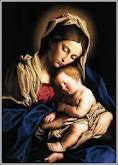 On the eighth day, according to law and custom, the child was circumcised. Joseph and Mary then presented him to God in the Temple in Jerusalem, and as the Law of Moses required, they ransomed their firstborn son with a sacrifice that consisted of a pair of turtledoves or two young pigeons.
On the eighth day, according to law and custom, the child was circumcised. Joseph and Mary then presented him to God in the Temple in Jerusalem, and as the Law of Moses required, they ransomed their firstborn son with a sacrifice that consisted of a pair of turtledoves or two young pigeons.In the Temple were two aged prophets who had long been awaiting the birth of the Christ child – Simeon and Anna. Each blessed the child in turn. Simeon took hold of the babe and prayed, "Now let thy servant depart in peace, for mine eyes have seen thy salvation."
A light to enlighten the gentiles, and the glory of thy people Israel.
Simeon then blessed them and prophesied to Mary: "This child is destined for the falling and the rising of many in Israel [that is, to be a critical factor in the descent and ascent of many souls], and to be a sign that will be opposed so that the inner thoughts of many will be revealed – and a sword will pierce your own soul too."
Then Anna came forth. She had been a widow for eighty-four years, and had not left the Temple in all that time, fasting and praying night and day. She came at that instant and gave thanks to the Lord, and spoke of the child to all those who were awaiting redemption in Jerusalem.
When all these rites and ceremonies were finished, Joseph and Mary took their infant son and returned home.
 Shortly thereafter, from Persia in the East came wise Astrologer Priests who had 'seen' in their sacred arts the birth of a Divine King of the Jews. They followed the Light of his Star and came to King Herod in Jerusalem. "Where is the child who has been born king of the Jews?", they asked him. "We have come to pay him homage."
Shortly thereafter, from Persia in the East came wise Astrologer Priests who had 'seen' in their sacred arts the birth of a Divine King of the Jews. They followed the Light of his Star and came to King Herod in Jerusalem. "Where is the child who has been born king of the Jews?", they asked him. "We have come to pay him homage."This of course frightened old Herod, as well as frightening the citizens of Jerusalem – for they well knew the violent tendencies of this jealous and brutal Idumean pretender. Herod quickly excused himself and called together his own priests, demanding an explanation. They told him that the Messiah was prophesied to be born in Bethlehem, in Judea. Herod then returned to the wise men from the East, and told them they would find the child in Bethlehem, shrewdly adding, "When you have found him, bring me word so that I, too, may go and worship him."
The wise men set out, and the Star they had seen rising in the East now led them directly to where the child was. "And when they were come into the house, they saw the young child with Mary his mother, and fell down, and worshipped him." Then they opened their treasures and presented him with gifts: Gold, the symbol of the royal bloodline, and the symbol of perfection of the soul; Frankincense, an herb that burns with pure white smoke, that was used for the incense in the Tabernacle, a symbol of prayer and sacrifice; and Myrrh, an herb of healing and embalming, used by Moses in the making of holy anointing oil, a symbol of rebirth and resurrection.
The wise men then left the holy family and returned to their own land. But having been warned in a dream to avoid Herod, they followed another road.
After they left, the angel of the Lord appeared to Joseph in a dream, and said, "Arise, and take the young child and his mother, and flee into Egypt, and remain there until I bring you word. For Herod is about to search for the child to destroy him."
When Herod realized he had been tricked by the wise men, he was furious. Once again, an order went out to kill all the little children in and around Bethlehem. But again, as in the story of Moses hidden in the bulrushes, it was too late. [W]hen Herod was dead, behold, an angel of the Lord appeared in a dream to Joseph in Egypt, saying, 'Arise, and take the young child and his mother, and go into the land of Israel: for they are dead which sought the young child's life. And he arose, and took the young child and his mother, and came into the land of Israel.***YOUR COMMENTS ARE ALWAYS WELCOME!***
And Please Note: If you enjoy my Blog Posts, you will certainly enjoy my books.
Published on December 23, 2011 21:05
December 22, 2011
THE CHRISTMAS MIRACLE, PART 1: GABRIEL
Tweet
 It began in the Temple. It began with a passionate prayer that opened the gates of heaven.
It began in the Temple. It began with a passionate prayer that opened the gates of heaven.
An elderly couple – the priest Zechariah and his wife Elizabeth, who both were "righteous before God, walking in all the commandments and ordinances of the Lord" –were nonetheless barren, just as Abraham and Sarah had been barren. So Zechariah entered the Sanctuary of the Temple and lit the incense – sending the smoke of prayer up to the Lord – while all the people, oppressed and desolate, gathered and waited outside the gates.
His prayer was heard, and the angel Gabriel appeared to the old man, just as he had done so long ago when he appeared to Abraham in Canaan, to announce the miraculous coming of the long-awaited son of his old age. Gabriel now said that this boy was to be named John – 'the Grace and Mercy of God'. John would be "filled with the Holy Spirit", and as God's agent he would go before the Lord to turn the hearts of parents toward their children, and to turn the hearts of children back to God, and in the spirit of Elijah he would "make ready a people prepared for the Lord."
But again, as with Abraham, there was a tinge of doubt. Zechariah said to the angel, "Whereby shall I know this? For I am an old man, and my wife well stricken in years." The angel assured him that all is possible for God, and John, like Isaac, would come as foretold. This time, however, in response to his doubt, Gabriel muted Zechariah until the time of the birth, so that he could remain turned inward in a state of prayer, and would not be able to speak more words of doubt.
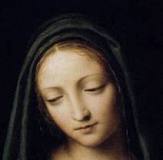 When Elizabeth was six months pregnant, God again sent forth Gabriel to Mary and Joseph of the royal House of David, in the town of Nazareth, in Galilee. 'Galilee' means 'revolution', as in the revolution of the Sun, and 'Nazareth' means a place of special 'sanctification'. Mary was in a state of great holiness. She was a "Virgin": that is, her soul was pure and completely free of sin. Joseph also was a righteous man, who understood dreams much like his namesake, the first Joseph. Mary and Joseph were betrothed, but they were not yet married.
When Elizabeth was six months pregnant, God again sent forth Gabriel to Mary and Joseph of the royal House of David, in the town of Nazareth, in Galilee. 'Galilee' means 'revolution', as in the revolution of the Sun, and 'Nazareth' means a place of special 'sanctification'. Mary was in a state of great holiness. She was a "Virgin": that is, her soul was pure and completely free of sin. Joseph also was a righteous man, who understood dreams much like his namesake, the first Joseph. Mary and Joseph were betrothed, but they were not yet married.
Gabriel came first to Mary, and said, "Hail, thou that art highly favored, the Lord is with thee: blessed art thou among women."
And, behold, thou shalt conceive in thy womb, and bring forth a son, and shalt call his name Jesus. He shall be great, and shall be called the Son of the Highest: and the Lord God shall give unto him the throne of his father David: And he shall reign over the house of Jacob for ever: and of his kingdom there shall be no end.
"Behold the handmaid of the lord," Mary responded. "Be it unto me according to thy word." Gabriel then departed, and Mary "arose" and "went into the hill country" to spend time with her kinswoman Elizabeth. "Blessed art thou among women," Elizabeth said, and "blessed is the fruit of thy womb." And Mary responded, "My soul doth magnify the Lord, and my spirit hath rejoiced in God my Saviour."
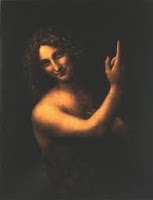 After three months, John was born in the hill country, and Mary returned home. Joseph now saw that she was with child, but "being a just man, and not willing to make her a public example", he planned to divorce her quietly (the only legal way to end a betrothal).
After three months, John was born in the hill country, and Mary returned home. Joseph now saw that she was with child, but "being a just man, and not willing to make her a public example", he planned to divorce her quietly (the only legal way to end a betrothal).
But while he thought on these things, behold, the angel of the Lord appeared unto him in a dream, saying, Joseph, thou son of David, fear not to take unto thee Mary thy wife: for that which is conceived in her is of the Holy Spirit.
Then Joseph, being "raised from sleep", awoke –the Eye of his Soul was opened -- and he did just as the angel Gabriel had said.
***YOUR COMMENTS ARE ALWAYS WELCOME!***
And Please Note: If you enjoy my Blog Posts, you will certainly enjoy my books.

 It began in the Temple. It began with a passionate prayer that opened the gates of heaven.
It began in the Temple. It began with a passionate prayer that opened the gates of heaven. An elderly couple – the priest Zechariah and his wife Elizabeth, who both were "righteous before God, walking in all the commandments and ordinances of the Lord" –were nonetheless barren, just as Abraham and Sarah had been barren. So Zechariah entered the Sanctuary of the Temple and lit the incense – sending the smoke of prayer up to the Lord – while all the people, oppressed and desolate, gathered and waited outside the gates.
His prayer was heard, and the angel Gabriel appeared to the old man, just as he had done so long ago when he appeared to Abraham in Canaan, to announce the miraculous coming of the long-awaited son of his old age. Gabriel now said that this boy was to be named John – 'the Grace and Mercy of God'. John would be "filled with the Holy Spirit", and as God's agent he would go before the Lord to turn the hearts of parents toward their children, and to turn the hearts of children back to God, and in the spirit of Elijah he would "make ready a people prepared for the Lord."
But again, as with Abraham, there was a tinge of doubt. Zechariah said to the angel, "Whereby shall I know this? For I am an old man, and my wife well stricken in years." The angel assured him that all is possible for God, and John, like Isaac, would come as foretold. This time, however, in response to his doubt, Gabriel muted Zechariah until the time of the birth, so that he could remain turned inward in a state of prayer, and would not be able to speak more words of doubt.
 When Elizabeth was six months pregnant, God again sent forth Gabriel to Mary and Joseph of the royal House of David, in the town of Nazareth, in Galilee. 'Galilee' means 'revolution', as in the revolution of the Sun, and 'Nazareth' means a place of special 'sanctification'. Mary was in a state of great holiness. She was a "Virgin": that is, her soul was pure and completely free of sin. Joseph also was a righteous man, who understood dreams much like his namesake, the first Joseph. Mary and Joseph were betrothed, but they were not yet married.
When Elizabeth was six months pregnant, God again sent forth Gabriel to Mary and Joseph of the royal House of David, in the town of Nazareth, in Galilee. 'Galilee' means 'revolution', as in the revolution of the Sun, and 'Nazareth' means a place of special 'sanctification'. Mary was in a state of great holiness. She was a "Virgin": that is, her soul was pure and completely free of sin. Joseph also was a righteous man, who understood dreams much like his namesake, the first Joseph. Mary and Joseph were betrothed, but they were not yet married.Gabriel came first to Mary, and said, "Hail, thou that art highly favored, the Lord is with thee: blessed art thou among women."
And, behold, thou shalt conceive in thy womb, and bring forth a son, and shalt call his name Jesus. He shall be great, and shall be called the Son of the Highest: and the Lord God shall give unto him the throne of his father David: And he shall reign over the house of Jacob for ever: and of his kingdom there shall be no end.
"Behold the handmaid of the lord," Mary responded. "Be it unto me according to thy word." Gabriel then departed, and Mary "arose" and "went into the hill country" to spend time with her kinswoman Elizabeth. "Blessed art thou among women," Elizabeth said, and "blessed is the fruit of thy womb." And Mary responded, "My soul doth magnify the Lord, and my spirit hath rejoiced in God my Saviour."
 After three months, John was born in the hill country, and Mary returned home. Joseph now saw that she was with child, but "being a just man, and not willing to make her a public example", he planned to divorce her quietly (the only legal way to end a betrothal).
After three months, John was born in the hill country, and Mary returned home. Joseph now saw that she was with child, but "being a just man, and not willing to make her a public example", he planned to divorce her quietly (the only legal way to end a betrothal).But while he thought on these things, behold, the angel of the Lord appeared unto him in a dream, saying, Joseph, thou son of David, fear not to take unto thee Mary thy wife: for that which is conceived in her is of the Holy Spirit.
Then Joseph, being "raised from sleep", awoke –the Eye of his Soul was opened -- and he did just as the angel Gabriel had said.
***YOUR COMMENTS ARE ALWAYS WELCOME!***
And Please Note: If you enjoy my Blog Posts, you will certainly enjoy my books.
Published on December 22, 2011 21:05
PALESTINE BEFORE THE BIRTH OF JESUS, PART 2: PERSECUTION, APOCALYPSE, AND MESSIAHS
Tweet
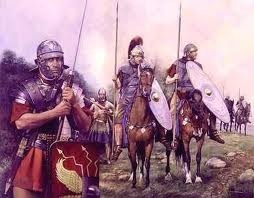 In yesterday's post, I talked about the religious and political divisiveness in ancient Palestine that had to do with various groups of Jewish citizens: The Pharisees, Sadducees, Zealots and Essenes.
In yesterday's post, I talked about the religious and political divisiveness in ancient Palestine that had to do with various groups of Jewish citizens: The Pharisees, Sadducees, Zealots and Essenes.
Another source of seething hostility in Palestine was a strange and completely new experience of the times, the phenomenon called 'Religious Persecution'. People had often wondered why God allowed good people to suffer despite their being good. But now, as the Jews found themselves being persecuted simply because of their religious practices, they began to wonder why it was that God would allow people to suffer because they were good! Such persecution seemed the very essence of evil.
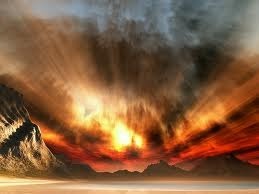 Fortunately, the belief in a cosmic struggle between Good and Evil carried with it a growing conviction that Good would ultimately triumph. Therefore, the experience of religious persecution, according to Julie Galambush in "The Reluctant Parting", "proved to be the catalyst for a developing belief that those who died for their faith in this world would be rewarded in another world - life after death through resurrection." Rather than being seen as unfortunate wretches who had been unaccountably forgotten by God, such people began to be seen as martyrs - religious heroes whom God would reward in the afterlife for their goodness and their faithfulness. The philosophical belief that God – and Good – would ultimately triumph over Evil, coupled with rising political tension with Rome and the anticipation of inevitable war, led to an increasingly 'Apocalyptic' view of the world: in other words, many Jews in Palestine began to believe that the 'End of the World' (at least as we know it) was rapidly approaching. God was about to triumph over Evil, He would judge the wicked, He would reward the just, and a New Order would dawn.
Fortunately, the belief in a cosmic struggle between Good and Evil carried with it a growing conviction that Good would ultimately triumph. Therefore, the experience of religious persecution, according to Julie Galambush in "The Reluctant Parting", "proved to be the catalyst for a developing belief that those who died for their faith in this world would be rewarded in another world - life after death through resurrection." Rather than being seen as unfortunate wretches who had been unaccountably forgotten by God, such people began to be seen as martyrs - religious heroes whom God would reward in the afterlife for their goodness and their faithfulness. The philosophical belief that God – and Good – would ultimately triumph over Evil, coupled with rising political tension with Rome and the anticipation of inevitable war, led to an increasingly 'Apocalyptic' view of the world: in other words, many Jews in Palestine began to believe that the 'End of the World' (at least as we know it) was rapidly approaching. God was about to triumph over Evil, He would judge the wicked, He would reward the just, and a New Order would dawn.
To lead God's legions to victory against hopelessly adverse political conditions, and to establish a new kingdom of God, a leader with divine power would be necessary. And thus, a Messianic hope was kindled in the heart of Judaism. God had promised Samuel that an anointed son of David would rule over the Israelites forever. Where was he? Now, after centuries of Assyrian, Babylonian, Persian, Greek, and Roman oppression, faith in God and hope for the future merged with the new belief that God was finally going to send Moshiach, "the anointed one", the Messiah, to rescue Israel and lead them to a new world.
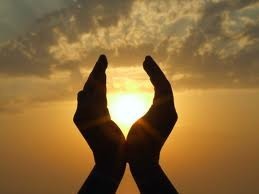 As Galambush writes: "Messianic expectations, cosmic dualism, martyrdom, and resurrection – an entire constellation of beliefs absent from ancient Israelite religion – suddenly took center stage. In some respects Jewish life continued as it had done for centuries: the rituals in the Jerusalem temple followed forms set down in Leviticus, and the rhythm of Sabbath and the festivals went on as always. But in the final centuries before the Common Era, Jewish popular imagination had come to occupy a far more colorful religious landscape, one in which history was fast approaching its end."
As Galambush writes: "Messianic expectations, cosmic dualism, martyrdom, and resurrection – an entire constellation of beliefs absent from ancient Israelite religion – suddenly took center stage. In some respects Jewish life continued as it had done for centuries: the rituals in the Jerusalem temple followed forms set down in Leviticus, and the rhythm of Sabbath and the festivals went on as always. But in the final centuries before the Common Era, Jewish popular imagination had come to occupy a far more colorful religious landscape, one in which history was fast approaching its end."
It was into this colorful, dangerous, and hopeful world that a child called Jesus, of the Tribe of Judah and the House of David, was born in Bethlehem.
***YOUR COMMENTS ARE ALWAYS WELCOME!***

 In yesterday's post, I talked about the religious and political divisiveness in ancient Palestine that had to do with various groups of Jewish citizens: The Pharisees, Sadducees, Zealots and Essenes.
In yesterday's post, I talked about the religious and political divisiveness in ancient Palestine that had to do with various groups of Jewish citizens: The Pharisees, Sadducees, Zealots and Essenes. Another source of seething hostility in Palestine was a strange and completely new experience of the times, the phenomenon called 'Religious Persecution'. People had often wondered why God allowed good people to suffer despite their being good. But now, as the Jews found themselves being persecuted simply because of their religious practices, they began to wonder why it was that God would allow people to suffer because they were good! Such persecution seemed the very essence of evil.
 Fortunately, the belief in a cosmic struggle between Good and Evil carried with it a growing conviction that Good would ultimately triumph. Therefore, the experience of religious persecution, according to Julie Galambush in "The Reluctant Parting", "proved to be the catalyst for a developing belief that those who died for their faith in this world would be rewarded in another world - life after death through resurrection." Rather than being seen as unfortunate wretches who had been unaccountably forgotten by God, such people began to be seen as martyrs - religious heroes whom God would reward in the afterlife for their goodness and their faithfulness. The philosophical belief that God – and Good – would ultimately triumph over Evil, coupled with rising political tension with Rome and the anticipation of inevitable war, led to an increasingly 'Apocalyptic' view of the world: in other words, many Jews in Palestine began to believe that the 'End of the World' (at least as we know it) was rapidly approaching. God was about to triumph over Evil, He would judge the wicked, He would reward the just, and a New Order would dawn.
Fortunately, the belief in a cosmic struggle between Good and Evil carried with it a growing conviction that Good would ultimately triumph. Therefore, the experience of religious persecution, according to Julie Galambush in "The Reluctant Parting", "proved to be the catalyst for a developing belief that those who died for their faith in this world would be rewarded in another world - life after death through resurrection." Rather than being seen as unfortunate wretches who had been unaccountably forgotten by God, such people began to be seen as martyrs - religious heroes whom God would reward in the afterlife for their goodness and their faithfulness. The philosophical belief that God – and Good – would ultimately triumph over Evil, coupled with rising political tension with Rome and the anticipation of inevitable war, led to an increasingly 'Apocalyptic' view of the world: in other words, many Jews in Palestine began to believe that the 'End of the World' (at least as we know it) was rapidly approaching. God was about to triumph over Evil, He would judge the wicked, He would reward the just, and a New Order would dawn. To lead God's legions to victory against hopelessly adverse political conditions, and to establish a new kingdom of God, a leader with divine power would be necessary. And thus, a Messianic hope was kindled in the heart of Judaism. God had promised Samuel that an anointed son of David would rule over the Israelites forever. Where was he? Now, after centuries of Assyrian, Babylonian, Persian, Greek, and Roman oppression, faith in God and hope for the future merged with the new belief that God was finally going to send Moshiach, "the anointed one", the Messiah, to rescue Israel and lead them to a new world.
 As Galambush writes: "Messianic expectations, cosmic dualism, martyrdom, and resurrection – an entire constellation of beliefs absent from ancient Israelite religion – suddenly took center stage. In some respects Jewish life continued as it had done for centuries: the rituals in the Jerusalem temple followed forms set down in Leviticus, and the rhythm of Sabbath and the festivals went on as always. But in the final centuries before the Common Era, Jewish popular imagination had come to occupy a far more colorful religious landscape, one in which history was fast approaching its end."
As Galambush writes: "Messianic expectations, cosmic dualism, martyrdom, and resurrection – an entire constellation of beliefs absent from ancient Israelite religion – suddenly took center stage. In some respects Jewish life continued as it had done for centuries: the rituals in the Jerusalem temple followed forms set down in Leviticus, and the rhythm of Sabbath and the festivals went on as always. But in the final centuries before the Common Era, Jewish popular imagination had come to occupy a far more colorful religious landscape, one in which history was fast approaching its end." It was into this colorful, dangerous, and hopeful world that a child called Jesus, of the Tribe of Judah and the House of David, was born in Bethlehem.
***YOUR COMMENTS ARE ALWAYS WELCOME!***
Published on December 22, 2011 06:00
December 21, 2011
PALESTINE BEFORE THE BIRTH OF JESUS, PART 1: PHARISEES, SADDUCEES, ZEALOTS AND ESSENES
Tweet
[image error] In yesterday's post I talked about the Maccabees, and how they waged a long and desperate battle against Greek rule and eventually became free.
Unfortunately, the new Kingdom of Judah would not be free for very long. After just 76 years, the descendants of the original Maccabees – through political intrigue, murder, and greed – lost the freedom which the courage of the Maccabees had won for them, and the Kingdom of Judah became a vassal state of Rome.
 You can read the whole sordid-and-utterly-fascinating-story in my little book From Joshua to Jesus: A Brief Chronicle of the Kings, Empires, Legends and Ideas, that Paved the Way to Bethlehem. Right now, however, as Christmas approaches, let's fast forward a 150 years or so and have a look at what was going on at the time of Jesus' birth.
You can read the whole sordid-and-utterly-fascinating-story in my little book From Joshua to Jesus: A Brief Chronicle of the Kings, Empires, Legends and Ideas, that Paved the Way to Bethlehem. Right now, however, as Christmas approaches, let's fast forward a 150 years or so and have a look at what was going on at the time of Jesus' birth.
During their years of exile in Babylonia and Persia, the Jewish people had absorbed the idea that life is a battlefield between Good and Evil. Now, in Roman-occupied Judea, the line between Good and Evil seemed to have been clearly drawn between the Jews and the Romans. This divisiveness was further fueled by several conflicts that had been brewing for a very long time:
First, there was the growing anger and cynicism caused by the corruption and violence of their own rulers as well as their occupiers. Various new groups and 'movements' - particularly the Pharisees, Sadducees, Zealots, and Essenes - were shaped and motivated by these sentiments.
The Sadducees were mostly members of the wealthy conservative elite. They had opened their hearts to the secular world of Greek culture and commerce, while insisting that the only worthy form of Judaism was to be found in a rather spiritless, fundamentalist, "pure letter-of-the-law" reading of the Torah. Philosophically, they denied such concepts as resurrection, personal immortality, or other ideas that were only found in the Oral tradition (eventually written down in the Talmud). Politically, they contented themselves with the way things were and resisted change – preferring instead to promote cordial relations with the Romans. Although they often held influential positions in society, they were unpopular with the masses who generally opposed all foreign influences.
 The Pharisees, the largest group, were mostly middle-class Jews who emphasized the exact keeping of the law as it had been interpreted by sages, elders, and rabbis. Politically, they were ardent anti-Hellenists and anti-Romans. The Pharisees were admired by the majority of Jews, but they were never a very large group since most people had neither the education nor the time to join the party and follow all their stringent rules regarding prayer, fasting, festival observance, tithing, etc. Pharisees were greatly influenced by Persian ideas of Good and Evil, and they adhered to the growing belief in the resurrection of the body with an afterlife of rewards and punishments. Over time, many of the finer impulses of Pharisaism would weaken into an empty religious formalism (as is ever the case), focusing on outward actions rather than the inward experience of the soul. Although the group had initially been exceedingly tolerant, this began to devolve into a feeling of contempt toward those Jews who did not meet their standards of behavior.
The Pharisees, the largest group, were mostly middle-class Jews who emphasized the exact keeping of the law as it had been interpreted by sages, elders, and rabbis. Politically, they were ardent anti-Hellenists and anti-Romans. The Pharisees were admired by the majority of Jews, but they were never a very large group since most people had neither the education nor the time to join the party and follow all their stringent rules regarding prayer, fasting, festival observance, tithing, etc. Pharisees were greatly influenced by Persian ideas of Good and Evil, and they adhered to the growing belief in the resurrection of the body with an afterlife of rewards and punishments. Over time, many of the finer impulses of Pharisaism would weaken into an empty religious formalism (as is ever the case), focusing on outward actions rather than the inward experience of the soul. Although the group had initially been exceedingly tolerant, this began to devolve into a feeling of contempt toward those Jews who did not meet their standards of behavior.
From among the more politically radical of the Pharisees there came a new group called the Zealots, meaning 'men of action'. These were revolutionary patriots, who sought to overthrow the Roman regime by whatever means necessary. They were strongest in Galilee. As the Romans committed one atrocity after another, the ranks of the Zealots grew. (By 66 A.D., their ranks would be swollen, and they would lead the charge against the Roman oppressors, initiating a long, costly, and bitter war, that finally ended with the inevitable Roman victory and the destruction of the Second Temple).
 At the other extreme were the Essenes. These were religious Jews who, in contrast with the Sadducees, now rejected the Temple and the Priesthood believing these had been defiled by corruption and murder. They also scorned what they felt was the spiritually empty and overly 'comfortable' life of the Pharisees. And unlike the Zealots, they had no taste for politics or violence. They chose, instead, to withdraw from secular activities and devote themselves entirely to spiritual purification and contemplation within austere religious communities. The Essenes are not mentioned in the New Testament, but Flavius Josephus, Philo, Pliny, and various others speak of them in their writings. According to the evidence of the Dead Sea Scrolls that were discovered in 1947, and the additional scrolls that were later excavated from a Jewish monastery in Qumran, the Essene communities worked and worshipped according to their own customs, studied and copied religious literature, practiced baptism and a communion meal, and lived an ascetic life devoted to spiritual growth and the perfection of the soul.
At the other extreme were the Essenes. These were religious Jews who, in contrast with the Sadducees, now rejected the Temple and the Priesthood believing these had been defiled by corruption and murder. They also scorned what they felt was the spiritually empty and overly 'comfortable' life of the Pharisees. And unlike the Zealots, they had no taste for politics or violence. They chose, instead, to withdraw from secular activities and devote themselves entirely to spiritual purification and contemplation within austere religious communities. The Essenes are not mentioned in the New Testament, but Flavius Josephus, Philo, Pliny, and various others speak of them in their writings. According to the evidence of the Dead Sea Scrolls that were discovered in 1947, and the additional scrolls that were later excavated from a Jewish monastery in Qumran, the Essene communities worked and worshipped according to their own customs, studied and copied religious literature, practiced baptism and a communion meal, and lived an ascetic life devoted to spiritual growth and the perfection of the soul.
(Come Back Tomorrow for Part 2: Persecution, Apocalypse, and Messiahs)
***YOUR COMMENTS ARE ALWAYS WELCOME!***

[image error] In yesterday's post I talked about the Maccabees, and how they waged a long and desperate battle against Greek rule and eventually became free.
Unfortunately, the new Kingdom of Judah would not be free for very long. After just 76 years, the descendants of the original Maccabees – through political intrigue, murder, and greed – lost the freedom which the courage of the Maccabees had won for them, and the Kingdom of Judah became a vassal state of Rome.
 You can read the whole sordid-and-utterly-fascinating-story in my little book From Joshua to Jesus: A Brief Chronicle of the Kings, Empires, Legends and Ideas, that Paved the Way to Bethlehem. Right now, however, as Christmas approaches, let's fast forward a 150 years or so and have a look at what was going on at the time of Jesus' birth.
You can read the whole sordid-and-utterly-fascinating-story in my little book From Joshua to Jesus: A Brief Chronicle of the Kings, Empires, Legends and Ideas, that Paved the Way to Bethlehem. Right now, however, as Christmas approaches, let's fast forward a 150 years or so and have a look at what was going on at the time of Jesus' birth. During their years of exile in Babylonia and Persia, the Jewish people had absorbed the idea that life is a battlefield between Good and Evil. Now, in Roman-occupied Judea, the line between Good and Evil seemed to have been clearly drawn between the Jews and the Romans. This divisiveness was further fueled by several conflicts that had been brewing for a very long time:
First, there was the growing anger and cynicism caused by the corruption and violence of their own rulers as well as their occupiers. Various new groups and 'movements' - particularly the Pharisees, Sadducees, Zealots, and Essenes - were shaped and motivated by these sentiments.
The Sadducees were mostly members of the wealthy conservative elite. They had opened their hearts to the secular world of Greek culture and commerce, while insisting that the only worthy form of Judaism was to be found in a rather spiritless, fundamentalist, "pure letter-of-the-law" reading of the Torah. Philosophically, they denied such concepts as resurrection, personal immortality, or other ideas that were only found in the Oral tradition (eventually written down in the Talmud). Politically, they contented themselves with the way things were and resisted change – preferring instead to promote cordial relations with the Romans. Although they often held influential positions in society, they were unpopular with the masses who generally opposed all foreign influences.
 The Pharisees, the largest group, were mostly middle-class Jews who emphasized the exact keeping of the law as it had been interpreted by sages, elders, and rabbis. Politically, they were ardent anti-Hellenists and anti-Romans. The Pharisees were admired by the majority of Jews, but they were never a very large group since most people had neither the education nor the time to join the party and follow all their stringent rules regarding prayer, fasting, festival observance, tithing, etc. Pharisees were greatly influenced by Persian ideas of Good and Evil, and they adhered to the growing belief in the resurrection of the body with an afterlife of rewards and punishments. Over time, many of the finer impulses of Pharisaism would weaken into an empty religious formalism (as is ever the case), focusing on outward actions rather than the inward experience of the soul. Although the group had initially been exceedingly tolerant, this began to devolve into a feeling of contempt toward those Jews who did not meet their standards of behavior.
The Pharisees, the largest group, were mostly middle-class Jews who emphasized the exact keeping of the law as it had been interpreted by sages, elders, and rabbis. Politically, they were ardent anti-Hellenists and anti-Romans. The Pharisees were admired by the majority of Jews, but they were never a very large group since most people had neither the education nor the time to join the party and follow all their stringent rules regarding prayer, fasting, festival observance, tithing, etc. Pharisees were greatly influenced by Persian ideas of Good and Evil, and they adhered to the growing belief in the resurrection of the body with an afterlife of rewards and punishments. Over time, many of the finer impulses of Pharisaism would weaken into an empty religious formalism (as is ever the case), focusing on outward actions rather than the inward experience of the soul. Although the group had initially been exceedingly tolerant, this began to devolve into a feeling of contempt toward those Jews who did not meet their standards of behavior. From among the more politically radical of the Pharisees there came a new group called the Zealots, meaning 'men of action'. These were revolutionary patriots, who sought to overthrow the Roman regime by whatever means necessary. They were strongest in Galilee. As the Romans committed one atrocity after another, the ranks of the Zealots grew. (By 66 A.D., their ranks would be swollen, and they would lead the charge against the Roman oppressors, initiating a long, costly, and bitter war, that finally ended with the inevitable Roman victory and the destruction of the Second Temple).
 At the other extreme were the Essenes. These were religious Jews who, in contrast with the Sadducees, now rejected the Temple and the Priesthood believing these had been defiled by corruption and murder. They also scorned what they felt was the spiritually empty and overly 'comfortable' life of the Pharisees. And unlike the Zealots, they had no taste for politics or violence. They chose, instead, to withdraw from secular activities and devote themselves entirely to spiritual purification and contemplation within austere religious communities. The Essenes are not mentioned in the New Testament, but Flavius Josephus, Philo, Pliny, and various others speak of them in their writings. According to the evidence of the Dead Sea Scrolls that were discovered in 1947, and the additional scrolls that were later excavated from a Jewish monastery in Qumran, the Essene communities worked and worshipped according to their own customs, studied and copied religious literature, practiced baptism and a communion meal, and lived an ascetic life devoted to spiritual growth and the perfection of the soul.
At the other extreme were the Essenes. These were religious Jews who, in contrast with the Sadducees, now rejected the Temple and the Priesthood believing these had been defiled by corruption and murder. They also scorned what they felt was the spiritually empty and overly 'comfortable' life of the Pharisees. And unlike the Zealots, they had no taste for politics or violence. They chose, instead, to withdraw from secular activities and devote themselves entirely to spiritual purification and contemplation within austere religious communities. The Essenes are not mentioned in the New Testament, but Flavius Josephus, Philo, Pliny, and various others speak of them in their writings. According to the evidence of the Dead Sea Scrolls that were discovered in 1947, and the additional scrolls that were later excavated from a Jewish monastery in Qumran, the Essene communities worked and worshipped according to their own customs, studied and copied religious literature, practiced baptism and a communion meal, and lived an ascetic life devoted to spiritual growth and the perfection of the soul.(Come Back Tomorrow for Part 2: Persecution, Apocalypse, and Messiahs)
***YOUR COMMENTS ARE ALWAYS WELCOME!***
Published on December 21, 2011 10:27
December 19, 2011
THE CHANUKAH STORY, PART 2: THE MACCABEES
Tweet
 In 167 BCE, in a small town near Jerusalem, a Greek official ordered an old Jewish priest named Mattathias to sacrifice a pig to the Greek gods. It would set a good example, the official said, and he promised Mattathias a handsome reward if he complied. The old priest defiantly refused, but while he was upbraiding the official a Hellenized Jew approached the altar and began preparing to offer the sacrifice. Mattathias, filled with a blazing anger and indignation, grabbed a sword and killed both the renegade Jew and the Greek official. He then turned to the crowd that had gathered and said, "Follow me, all of you who are for God's law and stand by the covenant!"
In 167 BCE, in a small town near Jerusalem, a Greek official ordered an old Jewish priest named Mattathias to sacrifice a pig to the Greek gods. It would set a good example, the official said, and he promised Mattathias a handsome reward if he complied. The old priest defiantly refused, but while he was upbraiding the official a Hellenized Jew approached the altar and began preparing to offer the sacrifice. Mattathias, filled with a blazing anger and indignation, grabbed a sword and killed both the renegade Jew and the Greek official. He then turned to the crowd that had gathered and said, "Follow me, all of you who are for God's law and stand by the covenant!"
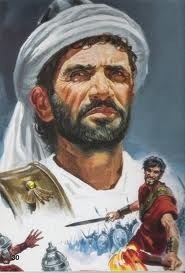 Those who joined Mattathias, including his five sons, hid in the hills and organized a guerrilla army led by the eldest son, Judah. Judah and his soldiers were so successful that they were given the nickname "the Hammers" – in Hebrew, "the Maccabees" – because of all the hammer blows they dealt the enemy. Though vastly outnumbered, they waged a long and bitter war, which they eventually won, and the legend of the Maccabees spread throughout the empire, causing the Seleucid rulers much consternation.
Those who joined Mattathias, including his five sons, hid in the hills and organized a guerrilla army led by the eldest son, Judah. Judah and his soldiers were so successful that they were given the nickname "the Hammers" – in Hebrew, "the Maccabees" – because of all the hammer blows they dealt the enemy. Though vastly outnumbered, they waged a long and bitter war, which they eventually won, and the legend of the Maccabees spread throughout the empire, causing the Seleucid rulers much consternation.
Antiochus first sent a small force to stop the revolt. Judah annihilated them. Then a larger force was sent. This time, Antiochus was so confident of victory that he brought slave auctioneers with him and promised them a large supply of Jewish slaves after the battle. Again, the Maccabees were victorious.
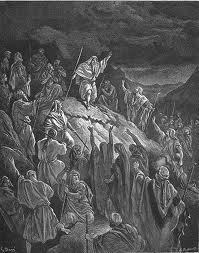 After the third year of fighting, Judah was able to reconquer Jerusalem and chase away the Hellenist sympathizers. When the Maccabees entered the Temple, they found it desecrated, filled with Greek statues, overgrown with vegetation, and its holy implements – including the golden Menorah (the Candlestick) – stolen: in fact, much of the Temple's wealth had been used by the Seleucid kings to pay the Romans their tributes. Judah and his followers threw out all the idols, cleansed everything, constructed a new Menorah, and rededicated the Temple on the 25th day of the Jewish month of Kislev, in 164 BCE.
After the third year of fighting, Judah was able to reconquer Jerusalem and chase away the Hellenist sympathizers. When the Maccabees entered the Temple, they found it desecrated, filled with Greek statues, overgrown with vegetation, and its holy implements – including the golden Menorah (the Candlestick) – stolen: in fact, much of the Temple's wealth had been used by the Seleucid kings to pay the Romans their tributes. Judah and his followers threw out all the idols, cleansed everything, constructed a new Menorah, and rededicated the Temple on the 25th day of the Jewish month of Kislev, in 164 BCE.
But they could only find enough oil to keep the Menorah burning for one day (it was supposed to burn continuously), and it was an eight day journey to bring back and prepare a new supply of oil. Miraculously, the oil continued to burn for the full eight days.
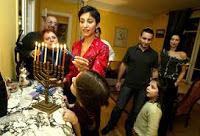 This miracle is still commemorated by the Festival of Lights, the Chanukah Festival, when Jews light candles on a Menorah for eight days.
This miracle is still commemorated by the Festival of Lights, the Chanukah Festival, when Jews light candles on a Menorah for eight days.
The word Chanukah comes from the Hebrew word chein, which means Divine 'Grace' – i.e., God's Light. With God's help, the Maccabees overcame incredible odds. The candle lighting ceremony of Chanukah is meant to remind us of God's Grace and to rekindle Hope in the human heart during times of adversity.
Judah's triumph, however, was not yet complete, and there would be many more years of fighting. But in battle after battle, the Seleucids were forced to retreat. Mattathias and Antiochus Epiphanes both died during this time, and four of Mattathias' sons would eventually die in battle, including Judah Maccabee. But at last, in 143 BCE, Antiochus' successor, no longer certain of victory, tired of the endless guerrilla warfare, and feeling weak and threatened by Rome, signed a peace treaty with Mattathias' only surviving son, Simon.
The Israelite Nation was free.
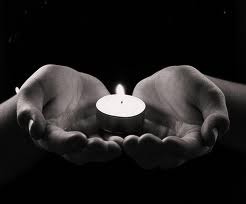 This year, Chanukah begins at sunset tonight, Tuesday, December 20, 2011. With all the hardship and suffering that people are enduring here in America and all around the world, perhaps we can all light a candle to remind us of God's Grace and to rekindle Hope in the human heart.
This year, Chanukah begins at sunset tonight, Tuesday, December 20, 2011. With all the hardship and suffering that people are enduring here in America and all around the world, perhaps we can all light a candle to remind us of God's Grace and to rekindle Hope in the human heart.
********* YOUR COMMENTS ARE ALWAYS WELCOME! ***

 In 167 BCE, in a small town near Jerusalem, a Greek official ordered an old Jewish priest named Mattathias to sacrifice a pig to the Greek gods. It would set a good example, the official said, and he promised Mattathias a handsome reward if he complied. The old priest defiantly refused, but while he was upbraiding the official a Hellenized Jew approached the altar and began preparing to offer the sacrifice. Mattathias, filled with a blazing anger and indignation, grabbed a sword and killed both the renegade Jew and the Greek official. He then turned to the crowd that had gathered and said, "Follow me, all of you who are for God's law and stand by the covenant!"
In 167 BCE, in a small town near Jerusalem, a Greek official ordered an old Jewish priest named Mattathias to sacrifice a pig to the Greek gods. It would set a good example, the official said, and he promised Mattathias a handsome reward if he complied. The old priest defiantly refused, but while he was upbraiding the official a Hellenized Jew approached the altar and began preparing to offer the sacrifice. Mattathias, filled with a blazing anger and indignation, grabbed a sword and killed both the renegade Jew and the Greek official. He then turned to the crowd that had gathered and said, "Follow me, all of you who are for God's law and stand by the covenant!"  Those who joined Mattathias, including his five sons, hid in the hills and organized a guerrilla army led by the eldest son, Judah. Judah and his soldiers were so successful that they were given the nickname "the Hammers" – in Hebrew, "the Maccabees" – because of all the hammer blows they dealt the enemy. Though vastly outnumbered, they waged a long and bitter war, which they eventually won, and the legend of the Maccabees spread throughout the empire, causing the Seleucid rulers much consternation.
Those who joined Mattathias, including his five sons, hid in the hills and organized a guerrilla army led by the eldest son, Judah. Judah and his soldiers were so successful that they were given the nickname "the Hammers" – in Hebrew, "the Maccabees" – because of all the hammer blows they dealt the enemy. Though vastly outnumbered, they waged a long and bitter war, which they eventually won, and the legend of the Maccabees spread throughout the empire, causing the Seleucid rulers much consternation. Antiochus first sent a small force to stop the revolt. Judah annihilated them. Then a larger force was sent. This time, Antiochus was so confident of victory that he brought slave auctioneers with him and promised them a large supply of Jewish slaves after the battle. Again, the Maccabees were victorious.
 After the third year of fighting, Judah was able to reconquer Jerusalem and chase away the Hellenist sympathizers. When the Maccabees entered the Temple, they found it desecrated, filled with Greek statues, overgrown with vegetation, and its holy implements – including the golden Menorah (the Candlestick) – stolen: in fact, much of the Temple's wealth had been used by the Seleucid kings to pay the Romans their tributes. Judah and his followers threw out all the idols, cleansed everything, constructed a new Menorah, and rededicated the Temple on the 25th day of the Jewish month of Kislev, in 164 BCE.
After the third year of fighting, Judah was able to reconquer Jerusalem and chase away the Hellenist sympathizers. When the Maccabees entered the Temple, they found it desecrated, filled with Greek statues, overgrown with vegetation, and its holy implements – including the golden Menorah (the Candlestick) – stolen: in fact, much of the Temple's wealth had been used by the Seleucid kings to pay the Romans their tributes. Judah and his followers threw out all the idols, cleansed everything, constructed a new Menorah, and rededicated the Temple on the 25th day of the Jewish month of Kislev, in 164 BCE. But they could only find enough oil to keep the Menorah burning for one day (it was supposed to burn continuously), and it was an eight day journey to bring back and prepare a new supply of oil. Miraculously, the oil continued to burn for the full eight days.
 This miracle is still commemorated by the Festival of Lights, the Chanukah Festival, when Jews light candles on a Menorah for eight days.
This miracle is still commemorated by the Festival of Lights, the Chanukah Festival, when Jews light candles on a Menorah for eight days. The word Chanukah comes from the Hebrew word chein, which means Divine 'Grace' – i.e., God's Light. With God's help, the Maccabees overcame incredible odds. The candle lighting ceremony of Chanukah is meant to remind us of God's Grace and to rekindle Hope in the human heart during times of adversity.
Judah's triumph, however, was not yet complete, and there would be many more years of fighting. But in battle after battle, the Seleucids were forced to retreat. Mattathias and Antiochus Epiphanes both died during this time, and four of Mattathias' sons would eventually die in battle, including Judah Maccabee. But at last, in 143 BCE, Antiochus' successor, no longer certain of victory, tired of the endless guerrilla warfare, and feeling weak and threatened by Rome, signed a peace treaty with Mattathias' only surviving son, Simon.
The Israelite Nation was free.
 This year, Chanukah begins at sunset tonight, Tuesday, December 20, 2011. With all the hardship and suffering that people are enduring here in America and all around the world, perhaps we can all light a candle to remind us of God's Grace and to rekindle Hope in the human heart.
This year, Chanukah begins at sunset tonight, Tuesday, December 20, 2011. With all the hardship and suffering that people are enduring here in America and all around the world, perhaps we can all light a candle to remind us of God's Grace and to rekindle Hope in the human heart.********* YOUR COMMENTS ARE ALWAYS WELCOME! ***
Published on December 19, 2011 21:01
December 18, 2011
THE CHANUKAH STORY, PART 1: THE REIGN OF TERROR
Tweet
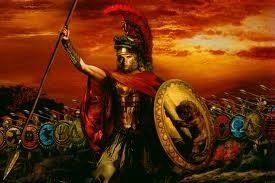 After the death of Alexander the Great, his three generals divvied up his Empire. The Greek city-states went to Antigonus. The northern region from Persia through Babylonia and Assyria was taken by Seleucis. The southern region, including Egypt and Palestine, was taken by Ptolemy.
After the death of Alexander the Great, his three generals divvied up his Empire. The Greek city-states went to Antigonus. The northern region from Persia through Babylonia and Assyria was taken by Seleucis. The southern region, including Egypt and Palestine, was taken by Ptolemy.
For 125 years, the Ptolemies (i.e., Ptolemy I, Ptolemy II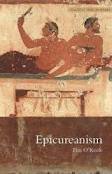 Even so, the Greeks expected their vassals to adopt their language, manners, customs, and ideals. Among other alien ideas, the Jews had to cope with the popular philosophy of Epicureanism that encouraged a life of cynicism, in which Divinity played no role in human life, and our only purpose was to free ourselves from concerns about morality so that we could pursue a life of physical pleasure. As has always been the case, this was a very fashionable and attractive philosophy for many people, especially among the young. Between the prosperity and the pleasure, many Jews were happy to be Hellenized.
Even so, the Greeks expected their vassals to adopt their language, manners, customs, and ideals. Among other alien ideas, the Jews had to cope with the popular philosophy of Epicureanism that encouraged a life of cynicism, in which Divinity played no role in human life, and our only purpose was to free ourselves from concerns about morality so that we could pursue a life of physical pleasure. As has always been the case, this was a very fashionable and attractive philosophy for many people, especially among the young. Between the prosperity and the pleasure, many Jews were happy to be Hellenized.
In response to this, however, there was a conservative reaction among those Jews who still revered the Mosaic Law and the religious culture of their ancestors, and who maintained a firm belief that the royal line of David would one day be restored to the throne. These Jews became members of a political group known as the Hasideans. So the nation was soon split between pro- and anti-Hellenists.
 Also during these years, there was constant fighting between the Ptolemies and the Seleucids, both of whom wanted control of the eastern Mediterranean seaboard which included Palestine. Finally, in 200 BCE the Seleucids, under Antiochus III, wrested Palestine from the Ptolemies. Still, Antiochus continued to allow the Jews freedom of worship and the right to govern themselves, so it didn't make much difference and once again many people were perfectly content to be tax-paying vassals of the latest Hellenic emperor.
Also during these years, there was constant fighting between the Ptolemies and the Seleucids, both of whom wanted control of the eastern Mediterranean seaboard which included Palestine. Finally, in 200 BCE the Seleucids, under Antiochus III, wrested Palestine from the Ptolemies. Still, Antiochus continued to allow the Jews freedom of worship and the right to govern themselves, so it didn't make much difference and once again many people were perfectly content to be tax-paying vassals of the latest Hellenic emperor.
Antiochus soon decided that he wanted to expand his empire even further, and he marched into Egypt intending to collect more property. There, however, he ran into the latest contender for world domination, the Romans, who had only recently become the masters of all Italy and were now beginning their own expansionist policy. One look at the Roman legions and Antiochus turned back.
 But he still thought he might be able to defeat these upstarts if he had the help of a truly united empire behind him. So Antiochus embarked on an intense project of Hellenization throughout his realm, including placing statues of himself, as a god, everywhere. In Palestine, of course, the Jews objected vehemently to this idol-worshipping project, and Antiochus decided to let them be -- so long as they demonstrated their continued loyalty by providing taxes and soldiers. But then Antiochus III died, and the son who soon took over, 'Antiochus Epiphanes', was not so agreeable.
But he still thought he might be able to defeat these upstarts if he had the help of a truly united empire behind him. So Antiochus embarked on an intense project of Hellenization throughout his realm, including placing statues of himself, as a god, everywhere. In Palestine, of course, the Jews objected vehemently to this idol-worshipping project, and Antiochus decided to let them be -- so long as they demonstrated their continued loyalty by providing taxes and soldiers. But then Antiochus III died, and the son who soon took over, 'Antiochus Epiphanes', was not so agreeable.
 In time, the aristocratic pro-Hellenist forces in Palestine, believing it to be in their best interest to support Antiochus Epiphanes in his Hellenization program, convinced him (and very likely bribed him) to appoint one of their members, a priest named Jason, as the new High Priest. The High Priesthood, which controlled the great wealth of the Temple, had fallen into a corrupt institution. Within a year there were Greek statues and Greek rites in the Temple. In response to this, more and more moderate Jews flocked to the anti-Hellenist Hasidean party, and the divisiveness in Palestine approached a state of civil war.
In time, the aristocratic pro-Hellenist forces in Palestine, believing it to be in their best interest to support Antiochus Epiphanes in his Hellenization program, convinced him (and very likely bribed him) to appoint one of their members, a priest named Jason, as the new High Priest. The High Priesthood, which controlled the great wealth of the Temple, had fallen into a corrupt institution. Within a year there were Greek statues and Greek rites in the Temple. In response to this, more and more moderate Jews flocked to the anti-Hellenist Hasidean party, and the divisiveness in Palestine approached a state of civil war.
Antiochus Epiphanes' Hellenization project was successful in the rest of the Seleucid Empire, and even in Palestine he had some supporters. So, believing he was strong enough to face the Romans, he headed once again to Egypt. He was quickly sent packing by the Roman legions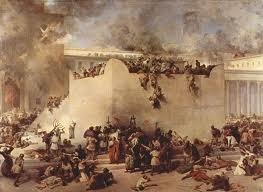 Antiochus, however, was very much alive. And when news of the uprising reached him, right on the heels of his humiliation by Rome, he was enraged. He marched into Jerusalem, slaughtered thousands of people indiscriminately, installed new statues in the Temple, looted the Temple's wealth, and invited pagans to come to Jerusalem and settle there. Still angry, he then outlawed the Sabbath, forced Jews to sacrifice pigs to pagan gods in their own Temple, and forbade circumcision.
Antiochus, however, was very much alive. And when news of the uprising reached him, right on the heels of his humiliation by Rome, he was enraged. He marched into Jerusalem, slaughtered thousands of people indiscriminately, installed new statues in the Temple, looted the Temple's wealth, and invited pagans to come to Jerusalem and settle there. Still angry, he then outlawed the Sabbath, forced Jews to sacrifice pigs to pagan gods in their own Temple, and forbade circumcision.
It was a reign of terror.
(Tomorrow, we'll talk about how the Jews fought back: The Maccabees )

 After the death of Alexander the Great, his three generals divvied up his Empire. The Greek city-states went to Antigonus. The northern region from Persia through Babylonia and Assyria was taken by Seleucis. The southern region, including Egypt and Palestine, was taken by Ptolemy.
After the death of Alexander the Great, his three generals divvied up his Empire. The Greek city-states went to Antigonus. The northern region from Persia through Babylonia and Assyria was taken by Seleucis. The southern region, including Egypt and Palestine, was taken by Ptolemy. For 125 years, the Ptolemies (i.e., Ptolemy I, Ptolemy II
 Even so, the Greeks expected their vassals to adopt their language, manners, customs, and ideals. Among other alien ideas, the Jews had to cope with the popular philosophy of Epicureanism that encouraged a life of cynicism, in which Divinity played no role in human life, and our only purpose was to free ourselves from concerns about morality so that we could pursue a life of physical pleasure. As has always been the case, this was a very fashionable and attractive philosophy for many people, especially among the young. Between the prosperity and the pleasure, many Jews were happy to be Hellenized.
Even so, the Greeks expected their vassals to adopt their language, manners, customs, and ideals. Among other alien ideas, the Jews had to cope with the popular philosophy of Epicureanism that encouraged a life of cynicism, in which Divinity played no role in human life, and our only purpose was to free ourselves from concerns about morality so that we could pursue a life of physical pleasure. As has always been the case, this was a very fashionable and attractive philosophy for many people, especially among the young. Between the prosperity and the pleasure, many Jews were happy to be Hellenized. In response to this, however, there was a conservative reaction among those Jews who still revered the Mosaic Law and the religious culture of their ancestors, and who maintained a firm belief that the royal line of David would one day be restored to the throne. These Jews became members of a political group known as the Hasideans. So the nation was soon split between pro- and anti-Hellenists.
 Also during these years, there was constant fighting between the Ptolemies and the Seleucids, both of whom wanted control of the eastern Mediterranean seaboard which included Palestine. Finally, in 200 BCE the Seleucids, under Antiochus III, wrested Palestine from the Ptolemies. Still, Antiochus continued to allow the Jews freedom of worship and the right to govern themselves, so it didn't make much difference and once again many people were perfectly content to be tax-paying vassals of the latest Hellenic emperor.
Also during these years, there was constant fighting between the Ptolemies and the Seleucids, both of whom wanted control of the eastern Mediterranean seaboard which included Palestine. Finally, in 200 BCE the Seleucids, under Antiochus III, wrested Palestine from the Ptolemies. Still, Antiochus continued to allow the Jews freedom of worship and the right to govern themselves, so it didn't make much difference and once again many people were perfectly content to be tax-paying vassals of the latest Hellenic emperor.Antiochus soon decided that he wanted to expand his empire even further, and he marched into Egypt intending to collect more property. There, however, he ran into the latest contender for world domination, the Romans, who had only recently become the masters of all Italy and were now beginning their own expansionist policy. One look at the Roman legions and Antiochus turned back.
 But he still thought he might be able to defeat these upstarts if he had the help of a truly united empire behind him. So Antiochus embarked on an intense project of Hellenization throughout his realm, including placing statues of himself, as a god, everywhere. In Palestine, of course, the Jews objected vehemently to this idol-worshipping project, and Antiochus decided to let them be -- so long as they demonstrated their continued loyalty by providing taxes and soldiers. But then Antiochus III died, and the son who soon took over, 'Antiochus Epiphanes', was not so agreeable.
But he still thought he might be able to defeat these upstarts if he had the help of a truly united empire behind him. So Antiochus embarked on an intense project of Hellenization throughout his realm, including placing statues of himself, as a god, everywhere. In Palestine, of course, the Jews objected vehemently to this idol-worshipping project, and Antiochus decided to let them be -- so long as they demonstrated their continued loyalty by providing taxes and soldiers. But then Antiochus III died, and the son who soon took over, 'Antiochus Epiphanes', was not so agreeable. In time, the aristocratic pro-Hellenist forces in Palestine, believing it to be in their best interest to support Antiochus Epiphanes in his Hellenization program, convinced him (and very likely bribed him) to appoint one of their members, a priest named Jason, as the new High Priest. The High Priesthood, which controlled the great wealth of the Temple, had fallen into a corrupt institution. Within a year there were Greek statues and Greek rites in the Temple. In response to this, more and more moderate Jews flocked to the anti-Hellenist Hasidean party, and the divisiveness in Palestine approached a state of civil war.
In time, the aristocratic pro-Hellenist forces in Palestine, believing it to be in their best interest to support Antiochus Epiphanes in his Hellenization program, convinced him (and very likely bribed him) to appoint one of their members, a priest named Jason, as the new High Priest. The High Priesthood, which controlled the great wealth of the Temple, had fallen into a corrupt institution. Within a year there were Greek statues and Greek rites in the Temple. In response to this, more and more moderate Jews flocked to the anti-Hellenist Hasidean party, and the divisiveness in Palestine approached a state of civil war. Antiochus Epiphanes' Hellenization project was successful in the rest of the Seleucid Empire, and even in Palestine he had some supporters. So, believing he was strong enough to face the Romans, he headed once again to Egypt. He was quickly sent packing by the Roman legions
 Antiochus, however, was very much alive. And when news of the uprising reached him, right on the heels of his humiliation by Rome, he was enraged. He marched into Jerusalem, slaughtered thousands of people indiscriminately, installed new statues in the Temple, looted the Temple's wealth, and invited pagans to come to Jerusalem and settle there. Still angry, he then outlawed the Sabbath, forced Jews to sacrifice pigs to pagan gods in their own Temple, and forbade circumcision.
Antiochus, however, was very much alive. And when news of the uprising reached him, right on the heels of his humiliation by Rome, he was enraged. He marched into Jerusalem, slaughtered thousands of people indiscriminately, installed new statues in the Temple, looted the Temple's wealth, and invited pagans to come to Jerusalem and settle there. Still angry, he then outlawed the Sabbath, forced Jews to sacrifice pigs to pagan gods in their own Temple, and forbade circumcision. It was a reign of terror.
(Tomorrow, we'll talk about how the Jews fought back: The Maccabees )
Published on December 18, 2011 12:21



